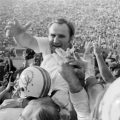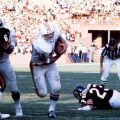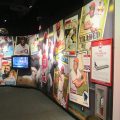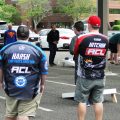The Curse of The UPS Car
While I was providing thoughtful NASCAR commentary for the Frontstretch, I noticed an interesting phenomenon about UPS-sponsored cars…that drivers either suffered significant decline with the UPS logo their car, or improved dramatically after it was gone. I detailed the whole curious anomaly in the article below, which first appeared on the Frontstretch in September of 2009.
Occasionally you hear comical stories of superstition in motorsports.
Joe Weatherly, whose untimely death in a crash is why stock cars have window nets today, suffered from triskaidekaphobia and once asked NASCAR to call the 13th Southern 500 the “12th Renewal of the Southern 500”. He also once asked to rename his 13th starting position in a race to “12a”.
There are green car phobias, which supposedly traces back to one of the Chevrolet brothers, Gaston, being killed in a Beverly Hills race. Gaston was driving a green car at the time and green has ever since been seen as bad luck, despite Bobby Labonte’s 2000 championship in an Interstate Batteries car.
Junior Johnson and Dale Earnhardt Sr. were both famous for their aversion to peanuts in the garage, and both were the targets of peanut-related practical jokes by team members and fellow competitors. One story told by Robert Yates describes a Johnson crew member painting foam packing peanuts and pretending to eat them near Johnson’s car, which sent Junior through the roof. “He didn’t think that was very funny”, chuckled Yates.
But who knows? Kevin Harvick claimed to lose an engine on a day where there were peanuts around the garage. Sometimes these things do take a life of their own.
With David Ragan pulling the UPS #6 into the Loudon garage after finishing 33rd and 13 laps down, placing him currently 30th in the standings, it’s nearly been forgotten that Ragan was seen as a driver with a bright future not very long ago, when AAA was sponsoring the car.
And it seems that there is some sort of whammy on any car that sports the famous UPS logo. Not anything dangerous, just something that makes racecars slow.
If your racing fan days go back a stretch, you remember how dominant Dale Jarrett once was, as difficult as that may be to believe seeing his last few seasons.
In 1996, Jarrett took over the Quality Car Ford Motor Credit No. 88 for Yates Racing. In that car he won two Daytona 500s, a Coca-Cola 600, and the Winston Cup championship in 1999, after falling 14 points short to Jeff Gordon in 1997. He won 20 races, scored 95 top fives, and 119 top tens in 167 races. That is rare supremacy in this sport.
Then Jarrett and Yates signed on with UPS, launching the now-famous “Race The Truck” campaign. For two years there was a slight downturn: six wins, 22 top fives and 37 top tens, and a fifth and ninth place finish in the standings. That’s hardly terrible in any two seasons, but it was the first noticeable decline in the performance of the No. 88.
Then in 2003, Jarrett fell off a cliff and never fully recovered. He won just one race and that win was his only top five in a season where Jarrett inexplicably finished 27th in points. For the rest of his career at Yates, Jarrett would score only one more win in three seasons and never again finished higher than 15th in the standings.
Despite the drop-off, UPS was happy enough with Jarrett as their spokesman to go along with him to Michael Waltrip Racing in 2007. In retrospect that seems like a giant blunder, but at the time most of the pundits saw the big name sponsors and manufacturer and the veteran’s three car team and predicted big things.
It didn’t work out that way. Jarrett burned his six champion provisionals very early in the season and made just 24 races in 2007, never once finishing in the top ten. At the end of the season, Jarrett finally tired of the aero disadvantages of racing in a parcel delivery truck and announced his retirement after five races in 2008. In those five races his highest finish was a 16th at Daytona.
The UPS hex then fell on David Reutimann. After a 2007 season where Reutimann was the top performer at MWR, Reutimann scored just four top tens in 2008, finally exhausting UPS’s patience despite their own role in driver declines. He still had the best results at MWR, but that wasn’t saying much.
After UPS left, with the much faster Aaron’s logo back on his car, Reutimann not only won his first ever Cup race at Charlotte, but he surprised everyone by challenging for a Chase spot well into the season. Reutimann has scored five top fives in 2009, after managing zero with the heavy UPS logo on the car. As I wrote this, he was also ahead of Dale Earnhardt Jr. and Kevin Harvick in the standings, two drivers that had little trouble acquiring sponsors in their careers. And 13 drivers separated him and the UPS driver.
UPS signed on with David Ragan starting in the 2009 season. In 2008 Ragan, with AAA on the car, seemed to have the best future of the younger drivers. He barely missed the Chase and finished 13th in points, a great improvement over finishing 23rd in 2007. He scored six top fives and 14 top tens in 2008 after scoring two top fives and three top tens in 2007. He had even scored 11th and 13th place finishes at Martinsville, a place where he had once been called a “dart without feathers” by Tony Stewart. Of course it seemed like a wise choice, if you didn’t consider the withering effect that UPS brown had on past drivers.
With the UPS logo on his car, Ragan went from riches to rags. The No. 6 has exactly one top ten this season, in the rain-shortened Daytona 500. Since then Ragan has finished in the top 15 just four times, never higher than 12th. His last three races have been three straight 33rds.
And he is 30th in the standings—if he drops one more position, it will be the same margin of decline that Jarrett suffered from 2002 to 2003.
It may be a strange statistic to look at, but what would be the odds of two different drivers, driving for two different teams, dropping 18 positions in the standings in one season while sharing only a sponsor in common? (And a manufacturer, I suppose, but many more drivers have driven Fords than have for UPS.)
Most all of this can probably be explained away without superstition. Yates in general was beginning a decline when they signed on with UPS. All of Michael Waltrip’s teams have struggled mightily. Roush Fenway has had problems with NASCAR no longer allowing them to test. You could just call it poor timing and foresight on UPS’s part.
But there isn’t any denying a noticeable correlation between a team’s performance with and without a brown UPS logo on a racecar. UPS appeared on Dale Jarrett’s car and he went from contending for titles to fighting to make races every week in just a few years. They appeared on David Reutimann’s car and Reutimann showed little improvement, then after their departure he rocketed to near playoff contention. UPS attached its logo to David Ragan’s car and he has gone from a young driver with a bright future to being one of those drivers who is rarely shown on TV unless he crashes or enters the pits backwards.
No doubt Matt Kenseth breathed a sigh of relief when UPS refused to replace DeWalt on the No. 17.
Did this post make your day a little bit?
I hope so. If it did, I would really appreciate your support.
When you use this link to shop on Amazon, you’ll help subsidize this great website…at no extra charge to you.
Thanks very much…come back soon!
Photo credit: rmkoske on VisualHunt / CC BY-SA
Photo credit: Darryl W. Moran Photography on VisualHunt / CC BY-ND
Photo credit: Dei3Nascar8 on Visual hunt / CC BY
Photo credit: The Freewheeling Daredevil on VisualHunt.com / CC BY
Photo credit: Hans J E on VisualHunt.com / CC BY-SA
Photo credit: pocketwiley on Visualhunt.com / CC BY






















